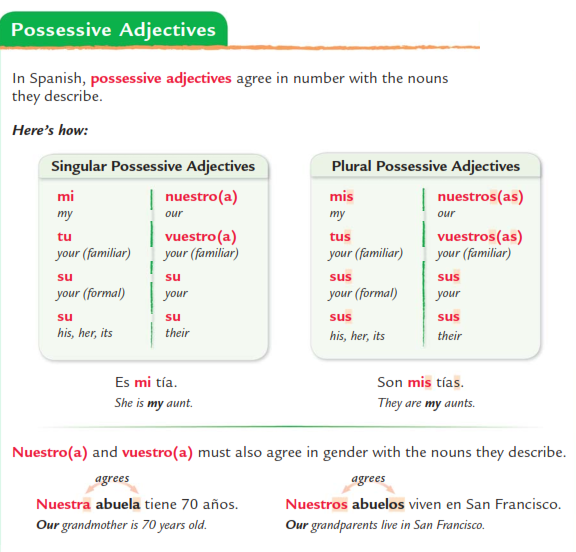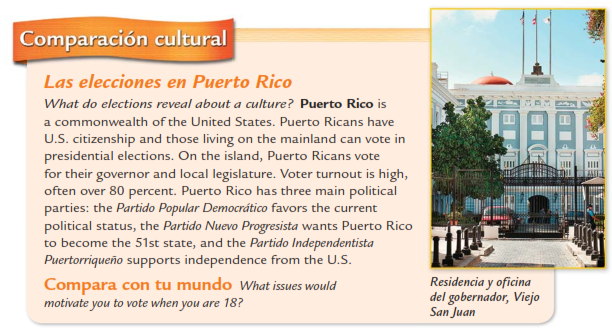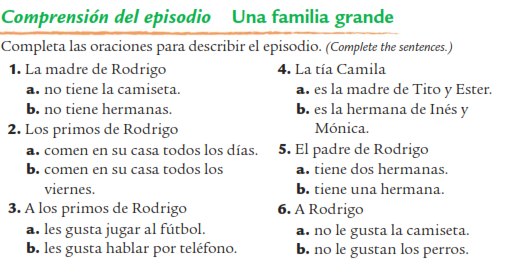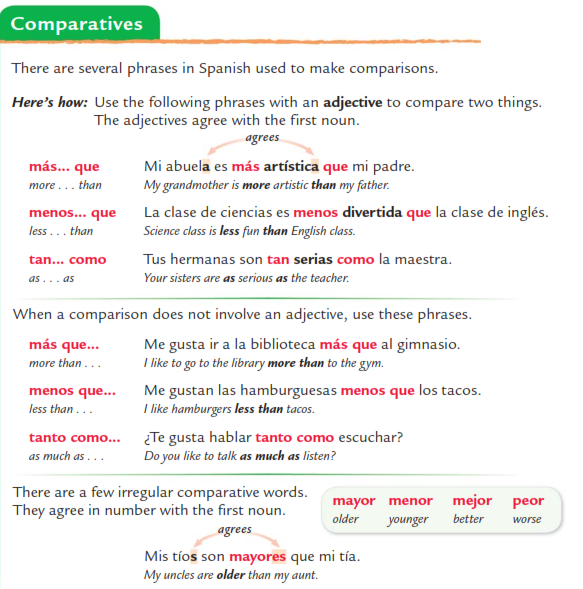Lesson 3-4 Grammar : En mi familia
Lesson 3-4 Grammar: En mi familia

Lesson 3-4 Grammar: En mi familia
English Grammar Connection: Possessive adjectives tell you who owns something or describe a relationship between people or things. The forms of possessive adjectives do not change in English, but they do change in Spanish.
They are my cousins. Ellos son mis primos.

Proceed to Next Page
Práctica de GRAMÁTICA 1 (Grammar Practice)

Click Image to Enlarge
The following are Grammar activities. Complete the activities in your Class Journal.

Activity 1
Las familias
Marisol habla de las familias y sus animales. Escoge el adjetivo posesivo correcto para expresar lo que dice.
(Choose the correct possessive adjectives.)
1. Nosotros tenemos tres primas. (Nuestros / Nuestras) primas son altas.
2. Ustedes tienen un abuelo. (Su / Nuestro) cumpleaños es el dos de abril.
3. Mi familia y yo tenemos una gata vieja. (Nuestra / Su) gata es Rubí.
4. Yo tengo dos hermanos mayores. (Mi / Mis) hermanos son estudiosos.
5. Mis abuelos tienen un perro. (Su / Mi) perro es perezoso.
6. ¡Feliz cumpleaños! Hoy tienes quince años. Es (tu / su) cumpleaños.
Activity 2
¿Qué hacen?
Usa un adjetivo posesivo y escribe qué actividades hacen estas personas. (Restate the relationship with a possessive adjective and tell what activities these people do.) modelo: La hermana de Alicia es inteligente. (sacar buenas notas) Su hermana saca buenas notas.
1. Los abuelos de nosotros no son muy serios. (escuchar música rock)
2. Los tíos de ustedes son trabajadores. (trabajar mucho)
3. La prima de Marisol no es perezosa. (hacer la tarea)
4. La madre de Rodrigo es atlética. (practicar deportes)
5. La hermana de nosotros es muy estudiosa. (leer muchos libros)
6. El padrastro de Luz es simpático. (pasar un rato con la familia)
Proceed to Next Page
GRAMÁTICA en contexto (Grammar in Context)

Telehistoria escena 2
Goal: Listen to the possessive adjectives Marisol and Rodrigo use to talk about their family members. Then, use possessive adjectives to talk about your family and the birthdays of people you know.
STRATEGIES
Cuando lees. List and practice words. While reading, list the words for family members, such as madre. Then practice! Say these words aloud several times. Say them in sentences and create questions with them.

Rodrigo: ¿Dónde está la camiseta? Sra. Vélez: ¡Ah, tus primos! (She picks up the phone and dials.)
Rodrigo: (explaining to Marisol) Ellos comen con nosotros todos los viernes. A nuestros primos les gusta jugar al fútbol.
Sra. Vélez: (on the phone) ¿Camila? Es Celia. Tengo una pregunta…
Rodrigo: Es mi tía Camila. La tía Camila es la madre de Ester y Tito. Mis primos tienen catorce y diez años.
Marisol: (pointing to a family portrait) ¿Es tu familia? Rodrigo: Mi madre tiene dos hermanas: Inés y Mónica. Mi padre tiene un hermano, Sergio, y una hermana, Camila.
Sra. Vélez: Rodrigo, tu primo Tito tiene la camiseta de tu amiga Alicia.
Rodrigo: (to Marisol) Mi primo tiene perros muy grandes. ¡No me gustan los perros de Tito!
Cuando escuchas. Track the people and actions. While listening, identify the people involved and the actions. What does each one say? Who helps solve the critical problem? What new problem arises?
The following are Grammar activities. Complete the activities in your Class Journal. Click Image to Enlarge
Proceed to Next Page
Presentación de GRAMÁTICA 2 (Presentation of Grammar)

Overview
English Grammar Connection: Comparatives are expressions used to compare two people or things. In English, comparative adjectives are formed by adding -er to the end of a word or by using more, less, and as.
Rodrigo is taller than his sister. Rodrigo es más alto que su hermana.
Lesson Activities
Activity 1
1. Marisol es tan simpática _________ su madrastra.
2. Ana es menor _________ Rodrigo.
3. Marisol corre tanto _________ sus padres.
4. Rodrigo tiene menos hermanos _________ José.
5. El tío Pablo toca la guitarra mejor _________ la tía Camila.
6. Ester es mayor _________ Tito.
Goal (Click on Comparison to View Video)
Goal: Learn to make comparisons. Then, use them to describe your family, friends, and yourself.





